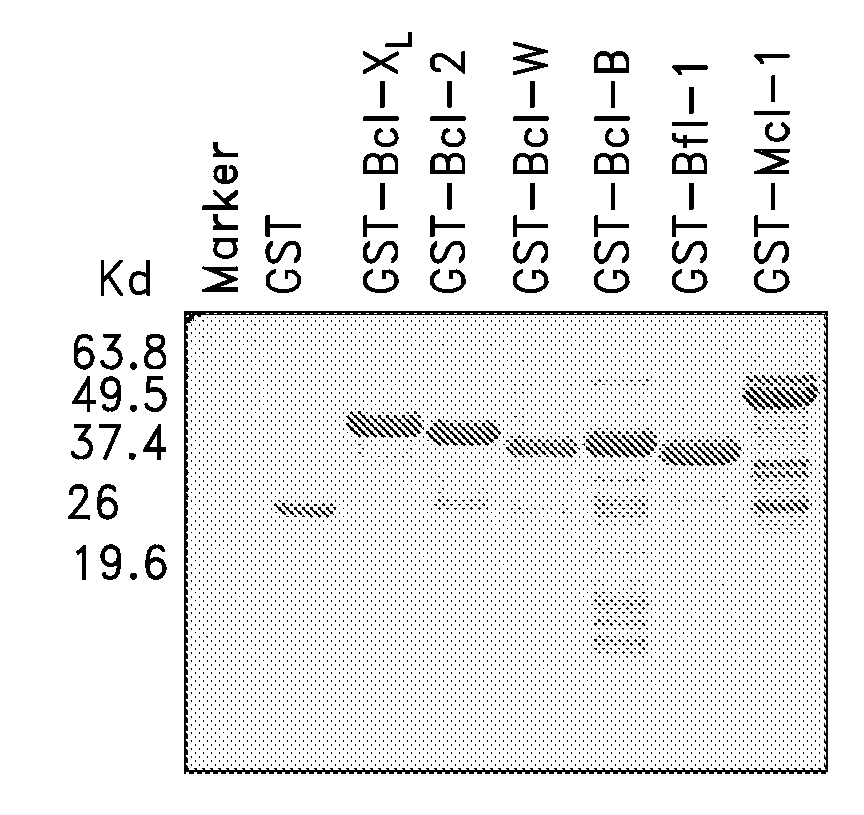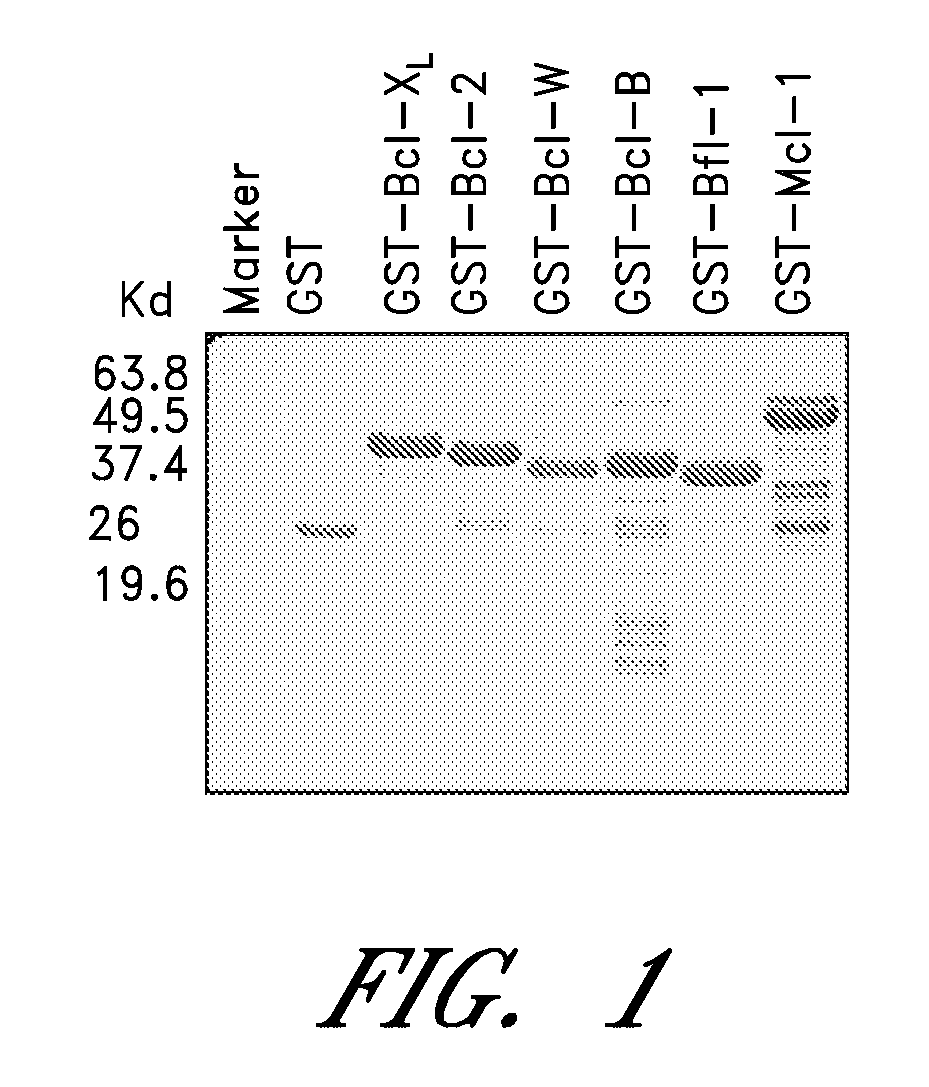Chemical inhibitors of bfl-1 and related methods
a technology of bfl-1 and bfl-1, applied in the field of molecular medicine and research, can solve the problems of inability to detect and detect bfl-1, inability to detect bfl-1, etc., and achieve the effects of reducing fluorescence, and reducing the number of bfl-1
- Summary
- Abstract
- Description
- Claims
- Application Information
AI Technical Summary
Benefits of technology
Problems solved by technology
Method used
Image
Examples
example 1
Assays for Screening for Inhibitors of Anti-Apoptotic Bcl-2 Polypeptides
[0177]To identify and optimize chemical inhibitors of Bfl-1, procedures were devised for producing multi-milligram quantities of purified recombinant Bfl-1 protein. A fluorescence polarization assay (FPA), using a Bfl-1-binding synthetic peptide conjugated with fluorescein isothiocyanate (FITC), was also devised. A preliminary screen was performed on approximately 10,000 compounds, demonstrating the suitability of the assay for the high-throughput screening.
[0178]To identify compounds selective for Bfl-1, FPAs were also developed for each of the other five anti-apoptotic members of the mammalian Bcl-2 family, Bcl-2, Bcl-XL, Mcl-1, Bcl-W, and Bcl-B. Using such assays, compounds can be screened that inhibit Bfl-1 but not other members of the Bcl-2-family, or that inhibit all members or a subset of members of the Bcl-2 family, providing chemical inhibitors specific for Bfl-1, subsets of the Bcl-2 family, and / or all...
example 2
Screening for Inhibitors of Anti-Apoptotic Bcl-2 Polypeptide Bfl-1
[0193]Purification of proteins and assays were performed as described in Example 1.
[0194]The GST-Bfl-1ΔTM protein was purified. The protein yield for the GST-Bfl-1 protein was approximately 5 mg per liter of cells. 10 μg of each purified protein was analyzed by sodium dodecyl sulfate-polyacrylamide gel electrophoresis (SDS-PAGE) followed by Coomassie Blue staining (FIG. 1). GST protein was used as control. The purity was over 95%, as determined by Coomassie Blue staining of material analyzed by SDS-PAGE. Other anti-apoptotic human Bcl-2 family proteins were also prepared for use in secondary screens of Bfl-1-binding compounds.
[0195]Fluorescence polarization assay (FPA) analysis of Bcl-2-family proteins was performed. Various concentrations of glutathione S transferase (GST) or GST-fusion proteins containing ΔTM versions of Bcl-2, Bcl-XL, Bfl-1, Mcl-1, Bcl-W, and Bcl-B were incubated with 5 nM FITC-conjugated-Bid BH3 p...
example 3
Inhibitors of Anti-Apoptotic Bcl-2 Polypeptide Bfl-1
[0203]Compounds were screened for inhibitory activity of Bfl-1 essentially as described in Example 1. Compounds were screened from the MLSMR library for binding to Bfl-1 and other anti-apoptotic Bcl-2 family proteins and inhibitory activity. Exemplary inhibitory compounds are shown, e.g., in Table 6 below. Table 6 shows the structure, FPA dose response and TR-FRET dose response curves of exemplary inhibitory compounds. The FPA and TR-FRET assays were performed essentially as described in Example I. Table 6 also provides the formula, molecular weight, values for ClogP and polar surface area, and the number of H bond acceptors, H bond donors and rotatable bonds. The logP value of a compound, which is the logarithm of its partition coefficient between n-octanol and water log(coctanol / cwater), is a measure of the compound's hydrophilicity.
[0204]Several additional compounds were identified. From the initial screen, at least two core sca...
PUM
| Property | Measurement | Unit |
|---|---|---|
| Structure | aaaaa | aaaaa |
| Biological properties | aaaaa | aaaaa |
| Therapeutic | aaaaa | aaaaa |
Abstract
Description
Claims
Application Information
 Login to View More
Login to View More - R&D
- Intellectual Property
- Life Sciences
- Materials
- Tech Scout
- Unparalleled Data Quality
- Higher Quality Content
- 60% Fewer Hallucinations
Browse by: Latest US Patents, China's latest patents, Technical Efficacy Thesaurus, Application Domain, Technology Topic, Popular Technical Reports.
© 2025 PatSnap. All rights reserved.Legal|Privacy policy|Modern Slavery Act Transparency Statement|Sitemap|About US| Contact US: help@patsnap.com



